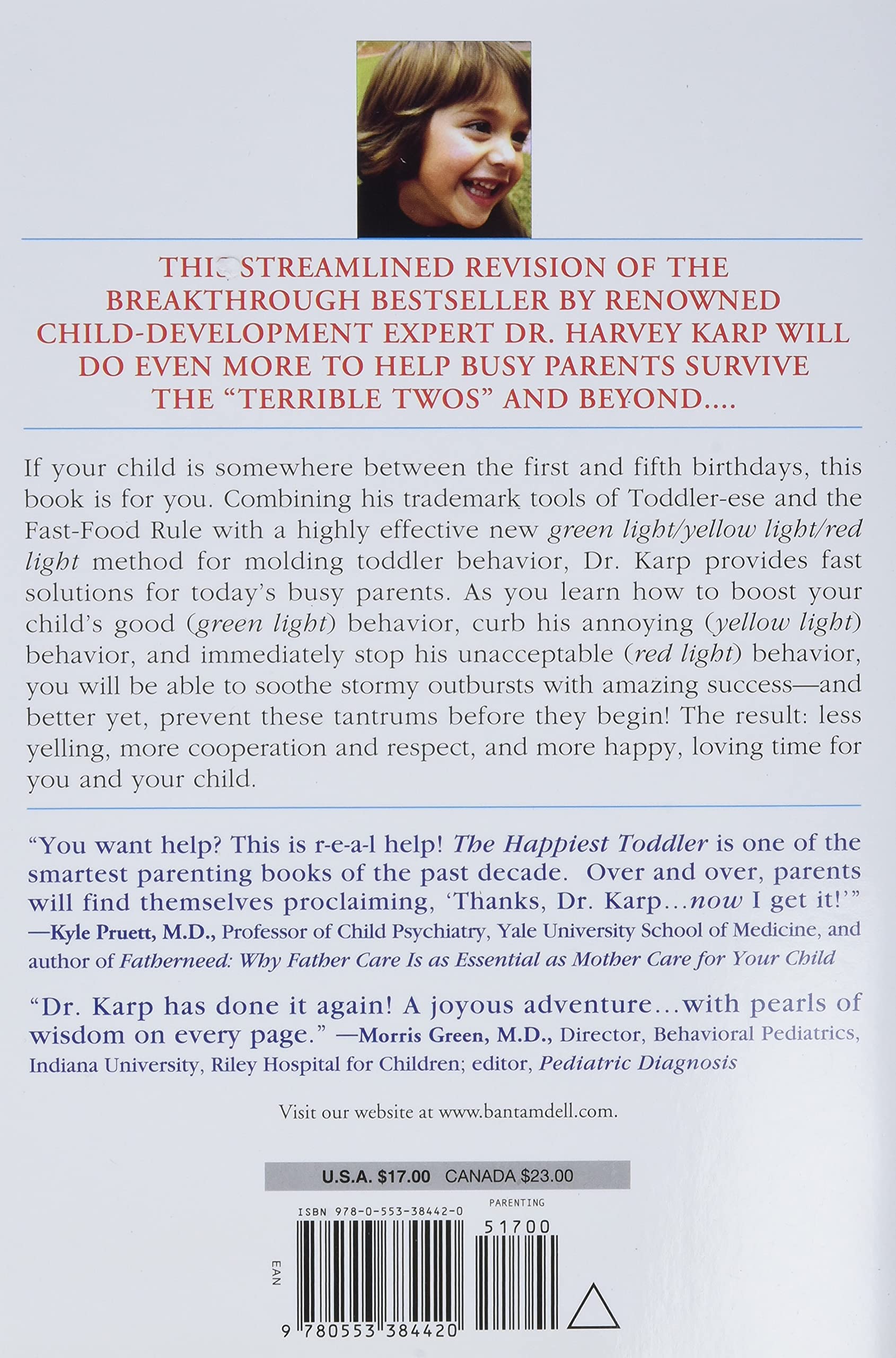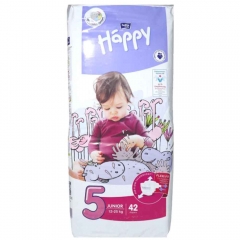-
 Thanh toán đa dạng, linh hoạtChuyển khoản ngân hàng, thanh toán tại nhà...
Thanh toán đa dạng, linh hoạtChuyển khoản ngân hàng, thanh toán tại nhà... -
 Miễn Phí vận chuyển 53 tỉnh thànhMiễn phí vận chuyển đối với đơn hàng trên 1 triệu
Miễn Phí vận chuyển 53 tỉnh thànhMiễn phí vận chuyển đối với đơn hàng trên 1 triệu -
 Yên Tâm mua sắmHoàn tiền trong vòng 7 ngày...
Yên Tâm mua sắmHoàn tiền trong vòng 7 ngày...
The Happiest Toddler on the Block: How to Eliminate Tantrums and Raise a Patient, Respectful, and Cooperative One- to Four-Year-Old: Revised Edition
-

- Mã sản phẩm: 0553384422
- (2320 nhận xét)

- ASIN:0553384422
- Publisher:Bantam; NO-VALUE edition (August 26, 2008)
- Language:English
- Paperback:336 pages
- ISBN-10:9780553384420
- ISBN-13:978-0553384420
- Item Weight:10.4 ounces
- Dimensions:5.5 x 0.93 x 8.3 inches
- Best Sellers Rank:#10,397 in Books (See Top 100 in Books) #21 in Parenting Boys #29 in Parenting Girls #68 in Baby & Toddler Parenting
- Customer Reviews:4.5 out of 5 stars 2,320Reviews

Mô tả sản phẩm
Product Description
Perfect for expecting parents who want to prepare themselves for the challenging toddler years (which starts around eight months of age), this essential guide, a national bestseller by respected pediatrician and child development expert Dr. Harvey Karp, not only helps reduce tantrums but makes happy kids even happier by boosting patience, cooperation, and self-confidence.
This streamlined revision of the breakthrough bestseller by renowned child-development expert Dr. Harvey Karp will do even more to help busy parents survive the “terrible twos” and beyond....
In one of the most revolutionary advances in parenting of the past twenty-five years, Dr. Karp revealed that toddlers often act like uncivilized little cavemen, with a primitive way of thinking and communicating that is all their own. In this revised edition of his parenting classic, Dr. Karp has made his innovative approach easier to learn—and put into action—than ever before.
Combining his trademark tools of Toddler-ese and the Fast-Food Rule with a highly effective new green light/yellow light/red light method for molding toddler behavior, Dr. Karp provides fast solutions for today’s busy and stressed parents. As you discover ways to boost your child’s good (green light) behavior, curb his annoying (yellow light) behavior, and immediately stop his unacceptable (red light) behavior you will learn how to soothe his stormy outbursts with amazing success—and better yet, prevent these outbursts before they begin! And the new thirty-item glossary of Dr. Karp’s parenting techniques will save you valuable time when you need to instantly calm an out-of-control child. The result: fewer tantrums, less yelling, and more happy, loving time for you and your child.
Review
"Karp offers a unique approach to the tantrums, melt-downs and overriding challenges that often accompany the demanding years from one to four.... Soothing and offers new hope and strategies to those who may have given up on making sense of the toddler years."—Publishers Weekly
“You want help? This is r-e-a-l help! The Happiest Toddler on the Block is one of the smartest parenting books of the past decade. Over and over, parents will find themselves proclaiming, "Thanks, Dr. Karp…Now I get it! “—Kyle Pruett, MD, Professor of Child Psychiatry, Yale University School of Medicine and author of Fatherneed: Why Fathercare is as Essential as Mother Care for Your Child
"Dr. Karp's approach is terrific...and fun! His book will help parents, grandparents and everyone who cares for toddlers be more effective."—Martin Stein, MD, Professor of Pediatrics, University of California San Diego, Children's Hospital San Diego
"Dr. Karp helps parents turn the "terrible" twos into "terrific" twos. His work will revolutionize the way our culture understands toddlers!"—Roni Cohen Leiderman, PhD, Associate Dean, Mailman Segal Institute for Early Childhood Studies, Nova Southeastern University
“Dr. Karp has done it again! Parents will find reading The Happiest Toddler on the Block a joyous adventure…with pearls of wisdom waiting for them on every page.”—Morris Green, MD, Director, Behavioral Pediatrics, Indiana University, Riley Hospital for Children, editor, Pediatric Diagnosis
“Dr. Karp's excellent approach gives parents the tools they need. His simple methods make raising rambunctious toddlers a whole lot easier.”—Steven Shelov, MD, Editor in chief of American Academy of Pediatrics’ Caring for Your Baby and Young Child
“Dr. Karp’s new book is an innovative, unique and thoroughly enjoyable guide to toddler behavior!” —Donald Middleton, MD, Professor of Family Medicine, University of Pittsburgh School of Medicine.
"Parents will be delighted by this clever approach to communicating with toddlers. It allows us to see the world from our children's unique point of view."—Janet Serwint, Professor of Pediatrics, Director of the Harriet Lane Children’s Clinic, Johns Hopkins School of Medicine
"It really works! With great humor and a gentle touch, Dr. Karp shows how to raise happy, well-behaved toddlers. His book is invaluable.—Gabrielle Redford, Senior Editor, AARP The Magazine (and mother of 17-month-old twins)
From the Back Cover
Toddlers can drive you bonkers...so adorable and fun one minute...so stubborn and demanding the next! Yet, as unbelievable as it sounds, there is a way to turn the daily stream of "nos" and "don'ts" into "yeses" and hugs...if you know how to speak your toddler's language. In one of the most useful advances in parenting techniques of the past twenty-five years, Dr. Karp reveals that toddlers, with their immature brains and stormy outbursts, should be thought of not as pint-size people but as pintsize...cavemen. Having noticed that the usual techniques often failed to calm crying toddlers, Dr. Karp discovered that the key to effective communication was to speak to them in their own primitive language. When he did, suddenly he was able to soothe their outbursts almost every time! This amazing success led him to the realization that children between the ages of one and four go through four stages of "evolutionary" growth, each linked to the development of the brain, and each echoing a step in prehistoric humankind's journey to civilization: - The "Charming Chimp-Child" (12 to 18 months): Wobbles around on two legs, grabs everything in reach, plays a nonstop game of "monkey see monkey do."- The "Knee-High Neanderthal" (18 to 24 months): Strong-willed, fun-loving, messy, with a vocabulary of about thirty words, the favorites being "no" and "mine."- The "Clever Caveman" (24 to 36 months): Just beginning to learn how to share, make friends, take turns, and use the potty.- The "Versatile Villager" (36 to 48 months): Loves to tell stories, sing songs and dance, while trying hard to behave.To speak to these children, Dr. Karp has developed two extraordinarily effective techniques: 1) The "fastfood" rule -- restating what your child has said to make sure you got it right; 2) The four-step rule -- using gesture, repetition, simplicity, and tone to help your irate Stone-Ager be happy again.Once you've mastered "toddler-ese," you will be ready to apply behavioral techniques specific to each stage of your child's development, such as teaching patience and calm, doing time-outs (and time-ins), praise through "gossiping," and many other strategies. Then all the major challenges of the toddler years -- including separation anxiety, sibling rivalry, toilet training, night fears, sleep problems, picky eating, biting and hitting, medicine taking -- can be handled in a way that will make your toddler feel understood. The result: fewer tantrums, less yelling, and, best of all, more happy, loving time for you and your child.
About the Author
Harvey Karp, MD., is an assistant professor of pediatrics at the UCLA School of Medicine, with a private practice in Santa Monica. Author of The Happiest Baby on the Block, Dr. Karp is a nationally renowned expert in child development, children’s health and the environment, and breast-feeding. He lives with his wife and daughter in California.
For further information and for information about the award-winning The Happiest Baby DVD/video and The Happiest Toddler DVD/video, please visit www.thehappiestbaby.com.
Excerpt. © Reprinted by permission. All rights reserved.
Chapter One
"Help! There's a Neanderthal in My Kitchen!"
"A first step is like watching the history of human civilization from small fishy things to Neanderthals unravel in one instant before your eyes."
-Anna Quindlen and Nick Kelsh, Naked BabiesMain Points:
All parents find toddlerhood challenging.
Parenting tips that work with older children often fail miserably with toddlers.
As your toddler grows, you are watching five million years of humanity unfold before your very eyes.
Toddlers pass through four stages of development that echo the evolution of our ancient ancestors.
Prehistoric Parenting: How to become the perfect ambassador to your little Stone Ager.
In the Beginning . . .
Tara, 14 months old, is proud of her newfound ability to walk. She tries to practice it every chance she gets. But right now she's confined to an exam room with me and her mom, Simone. Tara toddles over to the door. "Unghh!" She grunts reaching for the door-knob. "Unghh! Unghh!" She pushes against the closed door. Now she turns a pleading eye to me and starts slapping the door. She wants out!
Simone responds, "No, sweetheart. I know you want to leave, but we have to stay here a little longer. Let's look at this pretty book."
Tara's mom has lovingly acknowledged her daughter's feelings (a common parenting tip) and tried a favorite distraction (another good idea). This time, however, her efforts are rewarded with a crumpled red face, an open mouth . . . and . . . a long shrill scream that could shatter glass!
Taken aback by the tantrum's ferocity, her mom tries to engage her by heartily singing "The Itsy Bitsy Spider." Tara screams louder. So Simone decides to set a limit. "Tara! No screaming! Shhh. Stop or we'll have to leave, okay?" But by now Tara is in a full-scale meltdown. Embarrassed-and annoyed-Simone offers me an apology and hoists her little volcano over her shoulder; avoiding the stares of the other parents in the waiting room, she hurries to the exit.
Have you experienced your toddler's first temper tantrum yet?
Has your child discovered the word "No!"?
Do you get ambushed by fights that rise out of nowhere?
Are you mentally exhausted from shouting "Don't pull that!" and "Stop, now!"?
Parenting a toddler is filled with thrills and simple joys, but for most of us, it's also filled with the most difficult challenges we will encounter until the teen years. (No wonder it's often called "the first adolescence.")
Loving parents just like you have been scratching their heads for generations, wondering (and asking their pediatricians): What makes toddlers act the way they do? Why are they so unreasonable and tough to discipline?
I'm going to answer those questions for you. Better yet, I'll show you the way to a calmer toddler and a less-stressed household. But first it helps to see . . . the big picture.
Ah-ha! A New View of Toddlers
"A mind once stretched to a new idea never returns to its original size."
-Oliver Wendell Holmes
Until recently people mistakenly thought that babies cried because of terrible stomach pain. Then my book The Happiest Baby on the Block came along and revealed that newborns really cry because they need help turning on their "calming reflex." (Ah-ha!)
With toddlers, the "ah-ha" realization that perfectly explains their perplexing behavior is that these sweet kids, the apples of our eyes, are actually little Neanderthals!
Okay, okay. I've had more than one parent look at me strangely when I've said that. Please don't take the comparison as an insult. Allow me to explain how this new way of thinking will become your magic window for understanding what goes on in your toddler's mind-and help you turn conflict into cooperation in minutes-or less!
"The Little Adult Assumption": A Common Mistake
Recently John, a dad in my practice, said to me jokingly, "My toddler is a completely different animal than she was as a baby!" John was more on target than he knew!
Parenting a newborn involves overcoming some initial potholes (like colic and lack of sleep). But after a few months, life proceeds in a sunny way as your baby grows ever cuter and more fun. Then with her first lurching steps toddlerhood is off and running (and so are you)! Within months or even days, your waddling wonder will start developing a new sense of power and defiance. And suddenly you may feel the need to learn how to discipline your little one without squashing her spirit-or losing your mind.
Toddlers make the job of parenting a notch more complicated. During your baby's first year you happily gave her whatever she wanted (milk, a pacifier, a fresh diaper, a change of scenery). Now, however, you can only give her 90 to 95 percent of what she wants. The rest of the time you'll have to say no to her desire because
it is dangerous, or aggressive, or not what you want to do at that
moment.
And guess what? She's not going to like that!
So what do you do?
You try to lovingly "acknowledge her feelings." ("I see you're mad about leaving, but we really have to go. Okay?") You get a fit.
You try to reason. You get a fit.
You distract. You get a fit.
You give a warning. You get a fit.
You do a time-out. You get a fit.
Pretty soon you're having a fit too!
What happened?
Too often we make the mistake of speaking to toddlers as though they're small adults. They understand so much of what we say, it's sometimes hard to remember their limits. Psychologist Thomas Phelan calls this "the little adult assumption." He's right. Toddlers aren't small adults. Toddlers are unique-no longer babies, but not quite "kids." That's why hand-me-down discipline ideas designed for older kids don't work for them. They require a special approach all their own.
People will tell you you need to be more strict or more lenient. But what you really need are skills designed specifically for impulsive, distractible, inarticulate, self-absorbed, primitive toddlers.
First Let's Back Up-Way Back
"The child is nearer to the savage than to the angel."
-C. Gasquoine Hartley, "Mother and Son," 1923
Usually when people say, "It's ancient history," they mean, "Forget about it. It's not worth thinking about." But with toddlers, knowing a little ancient history is exactly what will help you be a terrific parent.
The starting place is your child's level of evolution. If that word makes you think about dinosaurs and fossils, you're on the right track! In dozens of key measures of brain maturity, toddlers are really pint-size Stone Agers! I know that sounds odd. But the language and problem-solving skills of a 12-month-old have more in common with a chimpanzee than a Girl Scout. Two-year-olds use mental processes very similar to those of cavemen. And three-year-olds think more like the first villagers, thousands of years before biblical times, than like your neighborhood Little Leaguers.
At birth your child begins a dramatic journey to adulthood. Starting from total helplessness, she will end up with the ability to recite Shakespeare, create paintings, and offer compassion and care to those in need-things no other animal has ever achieved. And the turning point for this major transition from brutes to humanity
occurs during the toddler years.
In fact, all five of the major feats that make human beings so
extraordinary blossom during the three incredible toddler years:
Walking on two legs
Manipulating things with our hands
Expressing words with our mouths
Combining ideas with our minds
Forming complicated social relationships
You knew your toddler was a busy bug, but that's really accomplishing things!
Mastering all those milestones requires a rapidly evolving brain-which is just what your toddler is blessed with. As the human race evolved, from knuckle-walking to using tools and words, brains got bigger and bigger. Up to a point.
Eventually the heads encasing our fetuses' big brains started becoming too large to slip through the birth canal. In order to get out our newborns had to develop smaller "no frills" brains equipped only to manage the bare necessities such as sucking, peeing, and keeping the heart beating. To make up for this "no frills" nervous system, Nature designed our children's brains to grow dramatically over the first year. By the time your baby's chubby legs take their first steps into toddlerhood, her big brain is off and running too!
A great way to understand this explosion of ability is to understand the biology behind it.
From Monkey Business to . . . Monkey Business?
Introducing "ORP": Sounds like something a baby would do, and it is!
"Our soul is full in all its parts of faint hints . . . flitting for an instant . . . and then gone forever, dim and scarcely audible murmurs of a great and prolonged life . . . of many generations."
-G. Stanley Hall, 1904
What comes out of a frog egg when it hatches? A little froggie? No! Out pops a little tadpole, more fish than amphibian, a small echo of the frog's evolutionary ancestry.
It's the same with humans. The entire history of humanity is encapsulated inside each developing fetus. How is that possible? Back in 1971, when I was a college student in Buffalo, New York, my embryology professor, Gordon Swartz, exposed me to a fascinating law of biology that has since become central to my understanding of toddlers.
This law states: Ontogeny recapitulates phylogeny. (Or ORP!)
Wait, don't run! I know this law sounds weird, but it's actually simple and very fun!
Let me translate ORP into plain English:
Ontogeny? That's your child's development. In short, her steady path of learning and growing, starting from the instant of her conception.
Recapitulates? That means "mirrors" or "repeats."
Phylogeny? That's the step-by-step process of our evolution beginning 1.5 billion years ago.
In short, as your child develops, from conception to adulthood, she will mirror many of the characteristics of our ancient ancestors as they slowly evolved into modern humans.
Here's a fun way to picture this in your mind: Imagine you could watch the growth of your baby like a time-lapse movie from the instant your sperm and egg met, all the way to her high school graduation. In a way, you'd also be watching how life on earth unfolded, a whirlwind tour of evolution, from worms to fish to rabbits to tiny monkeys.
Your fertilized egg, looking a bit like the first single-celled creature to appear on Earth (1.5 billion years ago), rapidly multiplies, morphing from a blackberry-shaped clump of cells to a tubular, wormlike embryo. At about five weeks your tiny fetus begins to rocket through a "fish" stage with flipper-like limbs and little gill-like slits on her neck (400 million years ago); then undergoes an "early mammal" stage with two lines of nipples on her chest and a tiny tail (180 million years ago); then several months before birth these disappear (leaving just the two nipples we're all born with and a few small tailbones at the bottom of the spine). As a beautiful newborn, your baby has tightly grasping fingers and toes, the ability to breathe and swallow at the same time, and maybe even some extra hair on her back, ears, and forehead-all characteristics of newborn monkeys (30 million years ago).
After birth this process continues to speed along. Once your child is able to pull herself onto two wobbly legs, she will have reached the evolutionary stage of the first teetering chimp-like steps (5 million years ago)! That's the starting bell that announces the arrival of toddlerhood, when even more tremendous advancements take place. Around her first birthday, she will be unsteady on her feet and her speech will be a jumble of grunts and gestures. Yet by her fourth birthday, her abilities will match what took the human race five million years to attain. She'll be able to run, speak, sing, and handily wield a fork or a toy hammer. She'll have a developed sense of humor and definite ideas about fairness, and her scribbled pictures will even become recognizable! In fact, by the end of toddlerhood, your child will have grown from just an adorable muffin to a smart little citizen able to start tackling reading and writing-tasks not achieved by even the brainiest adults until about eight thousand years ago.
Your toddler's development is not a perfect reflection of ancient evolution. She looks no more like a caveman or a chimp than a real Neanderthal looked like your 18-month-old tot. But her development does tend to echo the stages our ancestors passed through. That's why ORP is a fun way for you to picture your toddler's march to maturity, and a helpful guide for your communications with her.
Note: Those familiar with anthropology may be troubled by the license I take with nomenclature. Instead of Neanderthal I should have used the name Homo habilis and in place of caveman it would have been more accurate to say archaic Homo sapiens. Alas, those terms are a bit of a mouthful, so for the sake of simplicity, I chose names that were more familiar, albeit less precise.
Why It Helps to Think of Your Toddler
as a Living . . . Fossil
"What's past is prologue."
-William Shakespeare, The Tempest
Over the past fifty years, research in anthropology and on children's brain function has been building a steady foundation of facts to explain the uniqueness of toddlers.
Fossil hunters, using the bones of prehistoric animals, give us an increasingly clear picture of what the life and culture of the earliest humans were like. Huge advances in studying children's brain development have taught us what brain centers turn on at what ages, and what parts of movement, language, and thought they control.
Amazingly, the more we learn about how early man evolved and how young brains develop, the more we discover that there are many close parallels between them. In other words, your child is a kind of living fossil!
Again, no toddler is a carbon copy of a chimpanzee or Stone Ager. (Not even when life with one seems at its rockiest!) But as I will soon detail, communicating with your child will be a lot more successful when you understand how her development echoes prehistoric evolution.
Meet the Flintstones:
The Four Evolutionary Stages of Toddlerhood
Toddlerhood covers three years of exciting change that parallel five million years of human evolution. With so much happening, it's useful to see toddlers as falling into four distinct (but overlapping) phases:
The Charming Chimp-Child (12 to 18 months)
Some parents compare their wrinkled newborns to cute little monkeys, but toddlers? Developmentally, yes! To be more precise, by her first birthday your toddler has climbed the evolutionary ladder all the way up to the stage of the so-called Missing Link, between ape and man, who roamed the earth five million years ago.
- Mua astaxanthin uống có tốt không? Mua ở đâu? 29/10/2018
- Saffron (nhụy hoa nghệ tây) uống như thế nào cho hợp lý? 29/09/2018
- Saffron (nghệ tây) làm đẹp như thế nào? 28/09/2018
- Giải đáp những thắc mắc về viên uống sinh lý Fuji Sumo 14/09/2018
- Công dụng tuyệt vời từ tinh chất tỏi với sức khỏe 12/09/2018
- Mua collagen 82X chính hãng ở đâu? 26/07/2018
- NueGlow mua ở đâu giá chính hãng bao nhiêu? 04/07/2018
- Fucoidan Chính hãng Nhật Bản giá bao nhiêu? 18/05/2018
- Top 5 loại thuốc trị sẹo tốt nhất, hiệu quả với cả sẹo lâu năm 20/03/2018
- Footer chi tiết bài viết 09/03/2018
- Mã vạch không thể phân biệt hàng chính hãng hay hàng giả 10/05/2023
- Thuốc trắng da Ivory Caps chính hãng giá bao nhiêu? Mua ở đâu? 08/12/2022
- Nên thoa kem trắng da body vào lúc nào để đạt hiệu quả cao? 07/12/2022
- Tiêm trắng da toàn thân giá bao nhiêu? Có an toàn không? 06/12/2022
- Top 3 kem dưỡng trắng da được ưa chuộng nhất hiện nay 05/12/2022
- Uống vitamin C có trắng da không? Nên uống như thế nào? 03/12/2022
- [email protected]
- Hotline: 0909977247
- Hotline: 0908897041
- 8h - 17h Từ Thứ 2 - Thứ 7
Đăng ký nhận thông tin qua email để nhận được hàng triệu ưu đãi từ Muathuoctot.com
Tạp chí sức khỏe làm đẹp, Kem chống nắng nào tốt nhất hiện nay Thuoc giam can an toan hiện nay, thuoc collagen, thuoc Dong trung ha thao , thuoc giam can LIC, thuoc shark cartilage thuoc collagen youtheory dau ca omega 3 tot nhat, dong trung ha thao aloha cua my, kem tri seo hieu qua, C ollagen shiseido enriched, và collagen shiseido dạng viên , Collagen de happy ngăn chặn quá trình lão hóa, mua hang tren thuoc virility pills vp-rx tri roi loan cuong duong, vitamin e 400, dieu tri bang thuoc fucoidan, kem chống nhăn vùng mắt, dịch vụ giao hang nhanh nội thành, crest 3d white, fine pure collagen, nên mua collagen shiseido ở đâu, làm sáng mắt, dịch vụ cho thue kho lẻ tại tphcm, thực phẩm tăng cường sinh lý nam, thuoc prenatal bổ sung dinh dưỡng, kem đánh răng crest 3d white, hỗ trợ điều trị tim mạch, thuốc trắng da hiệu quả giúp phục hồi da. thuốc mọc tóc biotin


























 KHUYẾN MÃI LỚN
KHUYẾN MÃI LỚN Hỗ Trợ Xương Khớp
Hỗ Trợ Xương Khớp Bổ Não & Tăng cường Trí Nhớ
Bổ Não & Tăng cường Trí Nhớ Bổ Sung Collagen & Làm Đẹp
Bổ Sung Collagen & Làm Đẹp Bổ Thận, Mát Gan & Giải Độc
Bổ Thận, Mát Gan & Giải Độc Chăm Sóc Sức khỏe Nam Giới
Chăm Sóc Sức khỏe Nam Giới Chăm Sóc Sức khỏe Nữ Giới
Chăm Sóc Sức khỏe Nữ Giới Chăm sóc Sức khỏe Trẻ Em
Chăm sóc Sức khỏe Trẻ Em Thực Phẩm Giảm Cân, Ăn Kiêng
Thực Phẩm Giảm Cân, Ăn Kiêng Bổ Sung Vitamin & Khoáng Chất
Bổ Sung Vitamin & Khoáng Chất Bổ Tim Mạch, Huyết Áp & Mỡ Máu
Bổ Tim Mạch, Huyết Áp & Mỡ Máu Bổ Mắt & Tăng cường Thị lực
Bổ Mắt & Tăng cường Thị lực Điều Trị Tai Mũi Họng
Điều Trị Tai Mũi Họng Sức Khỏe Hệ Tiêu hóa
Sức Khỏe Hệ Tiêu hóa Chăm Sóc Răng Miệng
Chăm Sóc Răng Miệng Chống Oxy Hóa & Tảo Biển.
Chống Oxy Hóa & Tảo Biển.